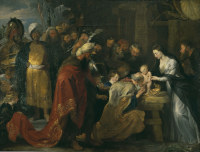Adoration of the Magi
The story of the Three Wise Men of the East has been popular among Christians for many centuries. Also known as the Three Kings or the Three Magi, they have been depicted in countless works of art. However, only one of the 4 gospels in the Bible mentions the story.
The story
The original story can be found in Matthew 2. After Jesus was born, "behold, there came wise men from the east to Jerusalem". They had seen a star that they considered indicative of the birth of the King of the Jews and had come to Jerusalem to find the child. When king Herod heard of their search, he wanted to know more about this possible competitor. His priests and scribes told him that such a king was to be born in Bethlehem, according to Micah's prophecy. Herod now sent for the three wise men and told them to go to Bethlehem and report their findings to him.
This Herod was in fact King Herod I, a.k.a. Herod the Great, tetrarch of Judea, who lived approx. from BC 73 to 4, and who governed the Judea region under Roman rule. He was not very popular among the Jewish population, mostly due to his attempts to enforce a Hellenistic culture. Traces of these attempts can be found in the ruins of Caesarea, the harbour city that Herod had built. Herod considered himself King of the Jews as well, although according to Jewish law he was not even Jewish.
The star guided the three men to Bethlehem where they discovered the child in the house the star stood over. The men offered the child their gifts: gold, incense and myrrh (a resin with a pleasant smell). This event is known as the Adoration of the Magi. That night, God told them in their dreams to ignore Herod's orders. The next day the Magi departed, avoiding Jerusalem on their way home.
When Herod learned that the wise men had deceived him, he saw no other option than to have all Bethlehem children under the age of three murdered. Jesus and his parents had already escaped to Egypt: Joseph had been warned by an angel, also in a dream.
So the three kings not only brought gifts, but also helped to save the child. In addition to the mysterious guiding star the subject matter couldn't fail but to inspire numerous painters.
The Bible does not mention the number of wise men, nor does it give their names or their colour: Balthasar, the black Caspar and Melchior. In the gospels of Mark, Luke and John, the wise men are not mentioned at all. In the Middle Ages, the number three was concluded from the number of the gifts. They were also given symbolic identities, representing all three biblical races, which meant that one of them had to be black. Psalms 72:10 mentions kings bringing gifts to a blessed king, which gave reason to believe the Magi were Kings.
The Old Testament considers Noah's three sons — Shem, Ham en Japheth — as the ancestors of three nations: the Semitic, Hamitic and Japhetic peoples. Ham had seen his drunken father naked and told his brothers; Noah cursed him for that. He is supposed to be the ancestor of the Canaanites and the African peoples. So a descendant of Ham could be black.
More symbolism: the gifts. The gold (presented by Balthasar), usually shown as gold coins, refers to the kingship of the newborn. Myrrh (Melchior's gift ) was a substance used in embalming the dead; it is therefore a reference to Christ's death. Caspar's frankincense indicates the divine status of the child.
Epiphany ("the appearance") still is a Christian holiday, celebrated on 6 January. It not only celebrates the visit of the three wise men, but generally the Revelation of God to Man in the person of Jesus.
The word magus, the singular form of magi, is probably derived from an ancient Persian word for priest.
The three wise men in art
A glance at the many paintings with The Three Magi as subject matter reveals them all showing the three kings in adoration before the Child and Mary. Joseph is not always shown, and neither are the ox and the ass. Usually Balthasar is the first to present a gift, being the most senior Magus. What varies most is the number of figures: paintings tend to get more baroque as the number of figures increases. There is much variation in background matter, which can be any sort of shelter, ranging from a cave, a stable or an inn, to a house.
This site features over thirty versions of the Adoration of the Magi.





